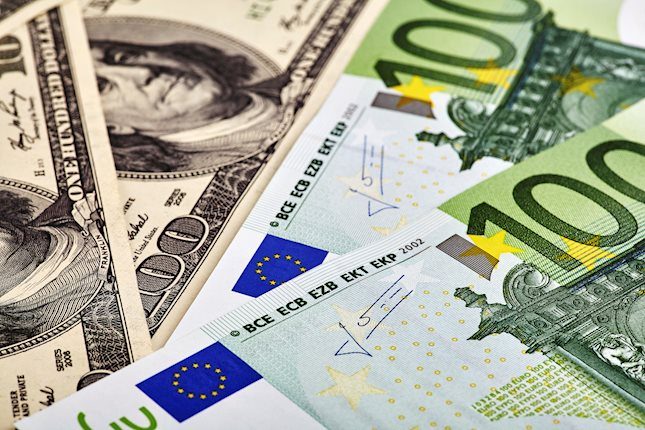- The Australian Dollar appreciates, possibly due to improved risk sentiment amid de-escalated tensions in the Middle East.
- The Australian currency could face challenges due to the market sentiment of RBA cutting policy rates before the year's end.
- The US Dollar may rebound as comments from Federal Reserve officials suggest a hawkish stance on monetary policy tightening.
The Australian Dollar (AUD) broke its two-day losing streak on Monday amid risk-on sentiment, supported by indications of de-escalating geopolitical tensions. An Iranian official's statement suggesting no immediate plans for retaliation against Israeli airstrikes contributes to the improved sentiment.
The Australian Dollar may encounter challenges ahead, particularly as domestic inflation continues to moderate, aligning with the Reserve Bank of Australia's (RBA) latest forecasts. Furthermore, the persistently tight labor market could lead to calls for an RBA rate reduction before the year's end.
The US Dollar Index (DXY), which gauges the US Dollar (USD) against six major currencies, faces pressure despite the increase in US Treasury yields. However, the potential downside for the USD pair could be restrained by comments from Federal Reserve (Fed) officials suggesting a move toward a more hawkish stance.
Daily Digest Market Movers: Australian Dollar appreciates on improved risk sentiment
- The People's Bank of China maintained its Loan Prime Rates (LPR) at 3.45% on Monday. The LPR serves as a crucial benchmark rate for Chinese banks when determining the interest rates for loans offered to their clients. Given the significant economic ties between China and Australia, any changes in Chinese monetary policy have the potential to impact the Australian market.
- The Chinese Ministry of Commerce has announced a new tariff on US goods. Specifically, China has imposed a duty of 43.5% on imports of propionic acid from the United States. This chemical is extensively utilized in various sectors, including food, feed, pesticides, and medical applications, as per Reuters report.
- The Australian Dollar gains ground with no significant geopolitical developments over the weekend. As per “The Guardian” report, Antony Blinken, the US Secretary of State, urged calm after an Iranian official stated that there is no immediate plan for retaliation to the reported Israeli missile strike. Blinken made these remarks while addressing the press on Friday after the G7 meeting of foreign ministers in Capri, Italy.
- Chicago Fed President Austan Goolsbee remarked on Friday that progress on inflation had "stalled," and the Federal Reserve's current restrictive monetary policy is appropriate. Meanwhile, Atlanta Fed President Raphael Bostic stated that the US central bank would refrain from cutting interest rates until the end of the year.
- Traders are expected to closely monitor upcoming Purchasing Managers Index (PMI) data from both countries on Tuesday, followed by the Australian Consumer Price Index (CPI) data on Wednesday and the US Gross Domestic Product Annualized on Thursday.
Technical Analysis: Australian Dollar remains below the major barrier of 0.6450
The Australian Dollar trades around 0.6440 on Monday. The AUD/USD pair remains below the pullback resistance of around 0.6456, along with the 14-day Relative Strength Index (RSI) remaining below the 50-level, suggesting a bearish sentiment. Notable support is identified at the psychological level of 0.6400. A break below the latter could put pressure on the AUD/USD pair to revisit the previous week’s low of 0.6362, followed by the major level of 0.6350.
On the upside, immediate resistance for the AUD/USD pair is anticipated at the major level of 0.6450, followed by the 14-day Exponential Moving Average (EMA) at 0.6476. A break above this level could lead the pair to reach the psychological level of 0.6500
AUD/USD: Daily Chart
Australian Dollar price this week
The table below shows the percentage change of the Australian Dollar (AUD) against listed major currencies this week. The Australian Dollar was the strongest against the Pound Sterling.
| USD | EUR | GBP | CAD | AUD | JPY | NZD | CHF | |
| USD | 0.02% | 0.15% | -0.05% | -0.06% | -0.02% | -0.13% | -0.04% | |
| EUR | -0.02% | 0.12% | -0.07% | -0.08% | -0.05% | -0.15% | -0.07% | |
| GBP | -0.15% | -0.13% | -0.20% | -0.21% | -0.17% | -0.27% | -0.19% | |
| CAD | 0.05% | 0.07% | 0.20% | -0.01% | 0.03% | -0.08% | 0.00% | |
| AUD | 0.06% | 0.08% | 0.20% | 0.01% | 0.03% | -0.07% | 0.02% | |
| JPY | 0.02% | 0.04% | 0.17% | -0.04% | -0.04% | -0.10% | -0.02% | |
| NZD | 0.13% | 0.16% | 0.26% | 0.08% | 0.07% | 0.10% | 0.09% | |
| CHF | 0.04% | 0.06% | 0.19% | -0.01% | -0.01% | 0.02% | -0.07% |
The heat map shows percentage changes of major currencies against each other. The base currency is picked from the left column, while the quote currency is picked from the top row. For example, if you pick the Euro from the left column and move along the horizontal line to the Japanese Yen, the percentage change displayed in the box will represent EUR (base)/JPY (quote).
Australian Dollar FAQs
One of the most significant factors for the Australian Dollar (AUD) is the level of interest rates set by the Reserve Bank of Australia (RBA). Because Australia is a resource-rich country another key driver is the price of its biggest export, Iron Ore. The health of the Chinese economy, its largest trading partner, is a factor, as well as inflation in Australia, its growth rate and Trade Balance. Market sentiment – whether investors are taking on more risky assets (risk-on) or seeking safe-havens (risk-off) – is also a factor, with risk-on positive for AUD.
The Reserve Bank of Australia (RBA) influences the Australian Dollar (AUD) by setting the level of interest rates that Australian banks can lend to each other. This influences the level of interest rates in the economy as a whole. The main goal of the RBA is to maintain a stable inflation rate of 2-3% by adjusting interest rates up or down. Relatively high interest rates compared to other major central banks support the AUD, and the opposite for relatively low. The RBA can also use quantitative easing and tightening to influence credit conditions, with the former AUD-negative and the latter AUD-positive.
China is Australia’s largest trading partner so the health of the Chinese economy is a major influence on the value of the Australian Dollar (AUD). When the Chinese economy is doing well it purchases more raw materials, goods and services from Australia, lifting demand for the AUD, and pushing up its value. The opposite is the case when the Chinese economy is not growing as fast as expected. Positive or negative surprises in Chinese growth data, therefore, often have a direct impact on the Australian Dollar and its pairs.
Iron Ore is Australia’s largest export, accounting for $118 billion a year according to data from 2021, with China as its primary destination. The price of Iron Ore, therefore, can be a driver of the Australian Dollar. Generally, if the price of Iron Ore rises, AUD also goes up, as aggregate demand for the currency increases. The opposite is the case if the price of Iron Ore falls. Higher Iron Ore prices also tend to result in a greater likelihood of a positive Trade Balance for Australia, which is also positive of the AUD.
The Trade Balance, which is the difference between what a country earns from its exports versus what it pays for its imports, is another factor that can influence the value of the Australian Dollar. If Australia produces highly sought after exports, then its currency will gain in value purely from the surplus demand created from foreign buyers seeking to purchase its exports versus what it spends to purchase imports. Therefore, a positive net Trade Balance strengthens the AUD, with the opposite effect if the Trade Balance is negative.
Information on these pages contains forward-looking statements that involve risks and uncertainties. Markets and instruments profiled on this page are for informational purposes only and should not in any way come across as a recommendation to buy or sell in these assets. You should do your own thorough research before making any investment decisions. FXStreet does not in any way guarantee that this information is free from mistakes, errors, or material misstatements. It also does not guarantee that this information is of a timely nature. Investing in Open Markets involves a great deal of risk, including the loss of all or a portion of your investment, as well as emotional distress. All risks, losses and costs associated with investing, including total loss of principal, are your responsibility. The views and opinions expressed in this article are those of the authors and do not necessarily reflect the official policy or position of FXStreet nor its advertisers. The author will not be held responsible for information that is found at the end of links posted on this page.
If not otherwise explicitly mentioned in the body of the article, at the time of writing, the author has no position in any stock mentioned in this article and no business relationship with any company mentioned. The author has not received compensation for writing this article, other than from FXStreet.
FXStreet and the author do not provide personalized recommendations. The author makes no representations as to the accuracy, completeness, or suitability of this information. FXStreet and the author will not be liable for any errors, omissions or any losses, injuries or damages arising from this information and its display or use. Errors and omissions excepted.
The author and FXStreet are not registered investment advisors and nothing in this article is intended to be investment advice.
Recommended content
Editors’ Picks

EUR/USD stays pressured toward 1.0500, US PPI data next in focus
EUR/USD remains heavy toward 1.0500 in the European session on Thursday, hanging at yearly lows. The Trump trades-driven unabated US Dollar demand and tarrifs threat weigh on the pair. Mixed Eurozone data fail to lift the Euro. Eyes turn to US PPI data and Fed Chair Powell.

GBP/USD holds losses near 1.2650 on relentless US Dollar buying
GBP/USD is holding losses while flirting with multi-month lows near 1.2650 in European trading on Thursday. The pair remains vulnerable amid a broadly firmer US Dollar and softer risk tone even as BoE policymakers stick to a cautious stance on policy. Speeches from Powell and Bailey are eyed.

Gold price approaches 100-day SMA/50% Fibo. confluence amid sustained USD buying
Gold price touches its lowest level since September 19, around $2,550 area during the early part of the European session on Thursday. The US Dollar buying remains unabated in the wake of optimism over the expected expansionary policies by US President-elect Donald Trump.

XRP struggles near $0.7440, could still sustain rally after Robinhood listing
Ripple's XRP is trading near $0.6900, down nearly 3% on Wednesday, as declining open interest could extend its price correction. However, other on-chain metrics point to a long-term bullish setup.

Trump vs CPI
US CPI for October was exactly in line with expectations. The headline rate of CPI rose to 2.6% YoY from 2.4% YoY in September. The core rate remained steady at 3.3%. The detail of the report shows that the shelter index rose by 0.4% on the month, which accounted for 50% of the increase in all items on a monthly basis.

Best Forex Brokers with Low Spreads
VERIFIED Low spreads are crucial for reducing trading costs. Explore top Forex brokers offering competitive spreads and high leverage. Compare options for EUR/USD, GBP/USD, USD/JPY, and Gold.
